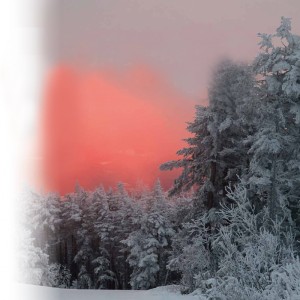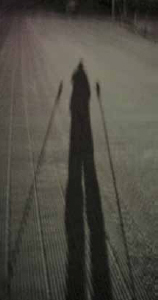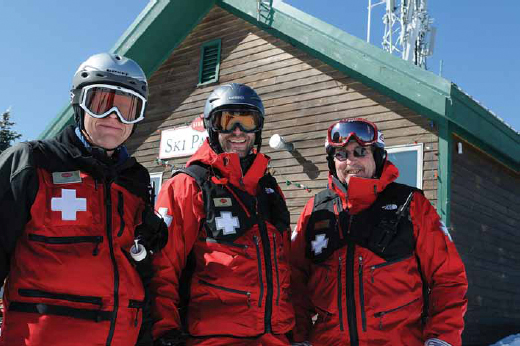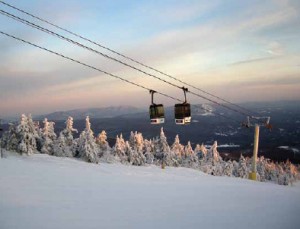By Andrew McKeever
Photography By Hubert Schriebl
 Arrive early, as in real early, 4:30 in the morning early, and there’s already a gentle thrum of sounds, lights and activity. An electronic sign at the entryway to the gondola reflects eerily off one of the windows in the base lodge. Somewhere in the distance, a generator hums, then another starts up, too. Shadowy figures move about in the near-darkness—members of the snow grooming team, perhaps, getting ready to do a final review of the snow and the trails.
Arrive early, as in real early, 4:30 in the morning early, and there’s already a gentle thrum of sounds, lights and activity. An electronic sign at the entryway to the gondola reflects eerily off one of the windows in the base lodge. Somewhere in the distance, a generator hums, then another starts up, too. Shadowy figures move about in the near-darkness—members of the snow grooming team, perhaps, getting ready to do a final review of the snow and the trails.
Promptly at 5 a.m., Gary Martin arrives and checks into the ski patrol’s base-side headquarters next to the Carlos Otis Clinic. He’s been a full-time member of Stratton’s ski patrol team for the past five years, but has been skiing with the patrol as a part-timer since 1981, fitting that in around a career with the sports equipment retailer Eastern Mountain Sports. Conveniently, his wife is also a full-time member of the ski patrol team and works as the head trainer of new would-be patrollers. They commute to Stratton each week during the ski season from their home in Freeport, Maine, driving over Thursday afternoons and returning Tuesdays, then back again.
What makes Martin’s work day routine a little different from others at Stratton is the extracurricular boots on the ground ritual that starts his day.
What makes Martin’s work day routine a little different from others at Stratton is the extracurricular boots on the ground ritual that starts his day. For the past five years, every day since he joined the patrol full-time, he has hiked from the base quarters up to the summit, to the low slung building in between the Ursa lift and the gondola the ski patrol calls home. In all kinds of weather. With a backpack full of supplies. That translates into about 100 uphill hikes per average ski season.
“It just became kind of a natural thing to do,” Martin explained. “I’d get up in the morning, drive to work, walk up the mountain and ski down. It gives me an opportunity to listen to what the groomers are doing and get an idea of what the conditions are like so I can re-assess it. It’s not a specific assignment on my part—when I get down I’ll tell the folks what the temperature is and wind is and what the surface conditions are like and what I encountered on my trip. It’s hard for the people sitting in Snow Cats to really get a feel for the snow as skiers or snowboarders would.”
What’s it like to start the day by burning a couple of thousand calories in the really early morning hours? There’s only one way to find out.
He doesn’t hike the same route day after day, but neither is he on a mission to hike each and every trail. He doesn’t do this because the ski patrol or the grooming people asked him to. Actually, it’s mainly for the exercise, he said, and it gives him a better idea of what the snow is going to be like when the mountain opens for business later in the morning.
When he’s not ski patrolling, Martin is an avid runner with several marathons under his belt. Keeping the training routine going in the wintertime, between travel, work and the weather, can get a little tough. The answer? A 6,000 or so foot uphill hike each morning, which is as good a cardio stress test as any that can be found anywhere.
His favorite route is straight up the North American or the Standard, which also happen to have the greatest vertical incline and offer the most grueling test of stamina and the highest heart rate opportunity.
Sometimes he has company. His wife will join him and so will a couple of the other patrollers. So does photographer Hubert Schriebl on occasion, an avid hiker in his own right.
There used to be more, a whole group that started hiking the mountain on weekends during the winter, but gradually, they dropped off. Only Martin, now 60 years old, has stuck with the ritual, day after day after day.
What’s it like to start the day by burning a couple of thousand calories in the really early morning hours? There’s only one way to find out.
Journalists have been known to keep strange hours, but usually see dawn’s early light because they’ve been up the entire night before. It’s a little different exploring the darkness and gloom of the pre-dawn morning as the day’s opening act, with a really strenuous burst of physical activity.
Even in the relatively shallow snowpack that covers Stratton this warmish morning, you just don’t show up in a pair of decent hiking boots and expect to finesse the trails. First come some elastic crampons and hiking cleats that stretch over the boots. Then comes the little headlamp, so you can see where you’re going. It is, after all, virtually pitch black out. Then some gloves. Finally the ski poles. Then we’re off.
His favorite route is straight up the North American or the Standard, which also happen to have the greatest vertical incline and offer the most grueling test of stamina and the highest heart rate opportunity. On this day, he opts for a different course, one that will take us first up the Old Log Road, up East Brynside to the Lower Standard. Then we’ll make a righthand turn onto the Interstate and then up the Upper Drifter. Eventually, we’ll come out near the summit by the windscreens near the gondola drop off.
Typically, this is a swift 35-minute or so journey to the top for Martin, but with a sluggish and somewhat more cardio-challenged writer in tow, it’s not long before it becomes apparent it will take longer today.
I run a bit myself, and keep up a fairly regular schedule of workouts at the local gym, but I’m no match for Martin. Five minutes into this trek, and my breathing is heavy and labored. And he’s the one with the backpack and all the gear, chattering away as we start our ascent.
One day, more than 30 years ago, Martin was skiing at Stratton when he took a tumble and one of his skis caused a serious gash in his forehead, he recalls. He was so impressed by the professionalism and quality of the care he received on the trail from the ski patrollers, he decided he wanted to give something back.
“My day to day routine isn’t that much different from all the other patrollers except for this little excursion,” he says. “But it’s really neat because I get the benefit of watching the stars and the moon and the sunrise, and I get ‘first tracks.’”
We hike along, and finally Martin takes mercy, and suggests we stop for a break. Good idea, I agree. It turns out to be the first of several.
We talk about running, and running marathons, and ski patrolling. He got into the trade in an unusual way. One day, more than 30 years ago, Martin was skiing at Stratton when he took a tumble and one of his skis caused a serious gash in his forehead, he recalls.
He was so impressed by the professionalism and quality of the care he received on the trail from the ski patrollers, he decided he wanted to give something back. When he was skilled enough as a skier, and had taken the requisite first aid courses, he qualified for the ski patrol.
To become a ski patroller, you have to learn how to ski and transport a sled at the same time, he continues. And you have to be an EMT (emergency medical technician) or pass the Outdoor Emergency Care course. That’s 120 hours of training time, and they’re constantly training or upgrading skills. They have to understand what to do in the event of basic injuries— sprains and the like—as well as the more serious stuff.
The break is over, and we trudge along. Or rather, I trudge along— Martin effortlessly glides over the snow, his elastic grippers seeming to barely make a purchase in the snow before his next stride. I struggle to keep up, breathing heavily. The elliptical trainer back at the gym is going to seem like child’s play after this, I think grimly.
By now I’m soaked in sweat, partially from the warmish weather on this day, but more from the exertion. Martin has plotted a course that will work out to be nearly a mile and a half, although we could make it into a twomiler if we took a slightly different route, he says, not totally unseriously. I shudder. Surely by now we are at least halfway there? Right? Please.
No.
At the top of Lower Standard, he notices some poles used by the groomers and other trail maintenance people to warn skiers away from dicey spots. It’s now light enough so we can make out the trees and the direction— upward—of the trail is now plainly evident. He comments on how well the groomers have maintained the trails, moving snow around in a kind of triage to give the maximum number of trails the best snow.
We press onwards up The Interstate. Conversation comes to a near stop as we crunch along in the snow and my heart rate starts to finally adjust to the demands I’m putting on it.
We stop again and Martin points to a spot on a trail where he took a major tumble a few years ago, rolling several hundred yards down a slope, the only serious accident he ever had as a predawn hiker.
“I was transitioning from a really steep part to the flats when one of my grippers broke and I went ‘oh-oh,’ and in about three seconds I was going probably 30 miles an hour head over heels backwards,” he said.
He had had the foresight to bring a ski helmet for just such a situation—too bad it was still in his backpack, he says.
“I used to do a lot of mountaineering so I knew enough to get your feet downhill,” he said. “If you hit something, it’s better to hit it with your feet than your head,” he explains.
I take a moment to process this thought.
“I finally came to a rest but I’d gone a long ways down. I’d lost both my poles and I was kind of stuck up there because I had one gripper broken,” he says. “It was too dangerous to walk back so I kind of ‘post-holed’ along the sides of the trails where I could actually penetrate the snow and made it to the summit.”
Nor was it a lot of fun to ski back down to the base, and when he did, he was informed the mountain wasn’t going to open until noon anyway, he recalled.
“That fall was the scariest thing that ever happened,” he says, speaking of his hiking.
Anything else weird ever happen, I ask.
“Once I saw a moose,” he replies.
Martin is still chattering away about the stars, the sunrise, pointing out the locations of Jupiter and Venus in the sky. Finally, the morning sun cracks through the gloom and the mountain is revealed in all its glory. The sweeping panoramic view is breathtaking. So is the quiet. We’re on Janeway now, the homestretch, still pounding away when the sight I’ve been fantasizing about for a good 20 minutes finally swings into view—the windscreens! We’re almost there. Revitalized by this, I suddenly find a new burst of energy and close the remaining distance to the summit. We made it! Well, it was a foregone conclusion that Martin would make it—not a slam dunk that I would, so I exulted in that moment of accomplishment.
We pause to admire the sunrise. It had taken us about an hour to cover a track that Martin would have normally done in about half that time, but he didn’t seem to mind. I should have been here yesterday—the dawn was amazing, with shafts of red light creating great visual drama, he said. This one looked pretty nice, too.
Finally, the morning sun cracks through the gloom and the mountain is revealed in all its glory. The sweeping panoramic view is breathtaking. So is the quiet.
We head into the little hut where the ski patrol maintains its mountaintop aerie. Functional-looking from the outside, it’s cozy and comfortable on the inside. I collapse onto a sofa while Martin, seemingly no more winded than if he had just come back from a quick trip to the corner store to pick up the morning’s newspaper, goes off to another room to change into the ski gear he’d stashed there earlier and look for his skis.
For Martin, the workday could now be said to be actually starting. From here he will ski down the mountain, and back to the ski patrol’s base station. Once there, he will be joined this day by about a dozen other patrollers getting ready for duty that morning, after absorbing the day’s briefing on conditions, the overnight grooming report, and the extra insights gleaned from Gary Martin’s boots on the ground/ skis on the snow analysis.
It’s now 7 a.m. and the mountain is no longer quiet. People are moving around, the gondola is running, and snowmobiles with trail groomers and others charged with making sure all is in readiness for the day’s customers are buzzing around. It seems like it’s been a long day already. Is it time for lunch yet?
Now having done this once in snow, I start planning the sequel— another hike up Stratton, on real dirt after the snow has melted. That would be easier, right?
Unfortunately, not so, Martin replies as we part ways.
One more for the bucket list. ◊
Andrew McKeever is a frequent contributor to STRATTON MAGAZINE.




